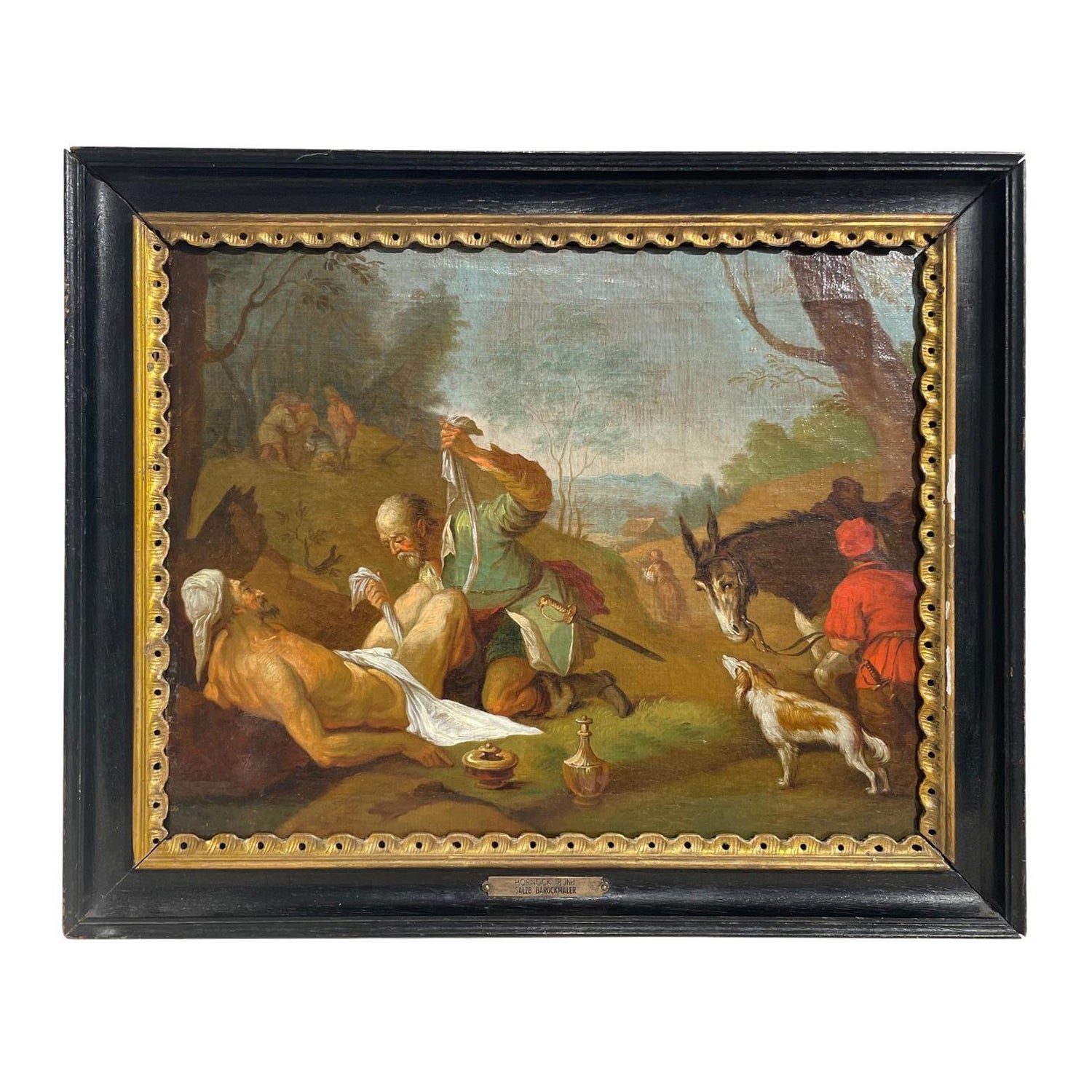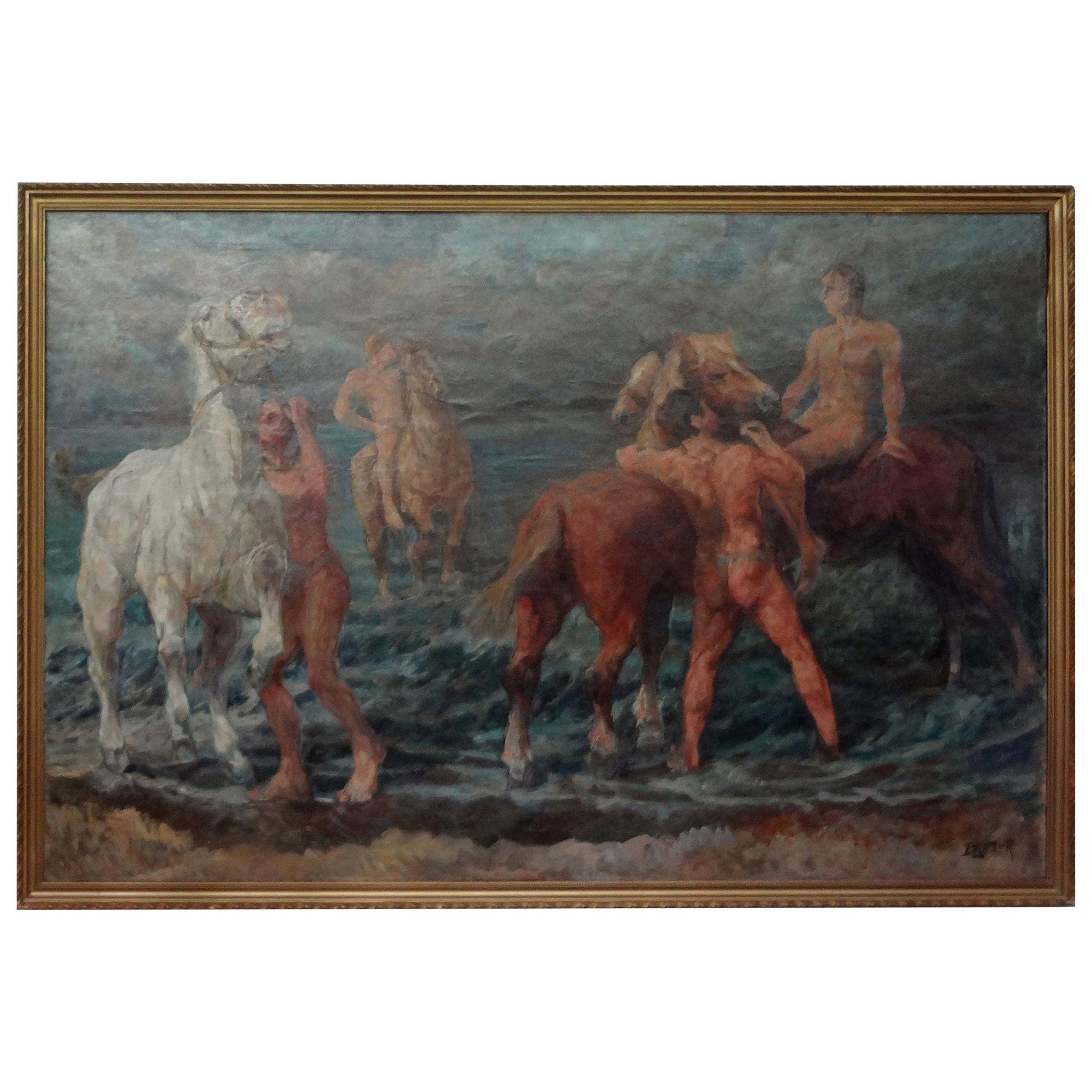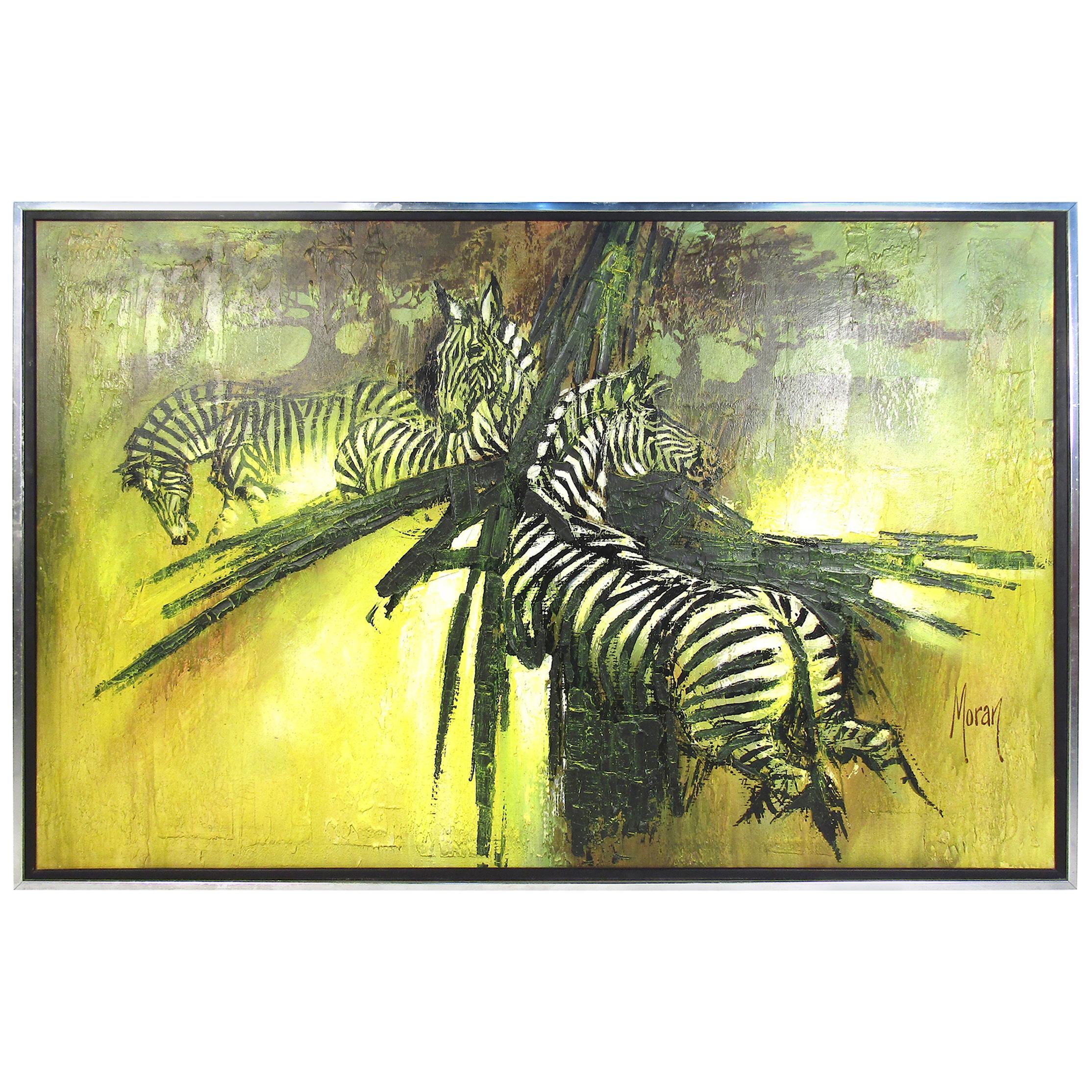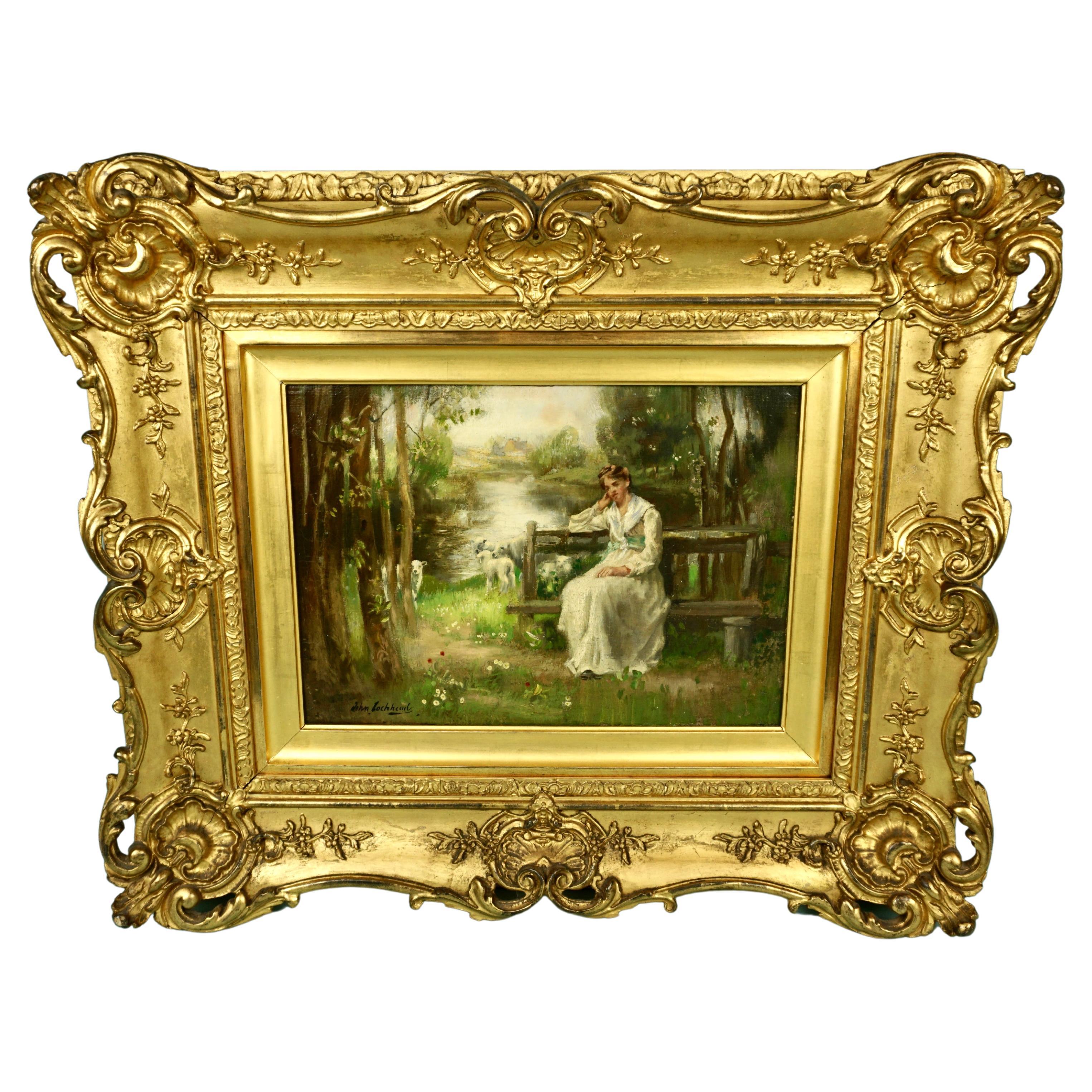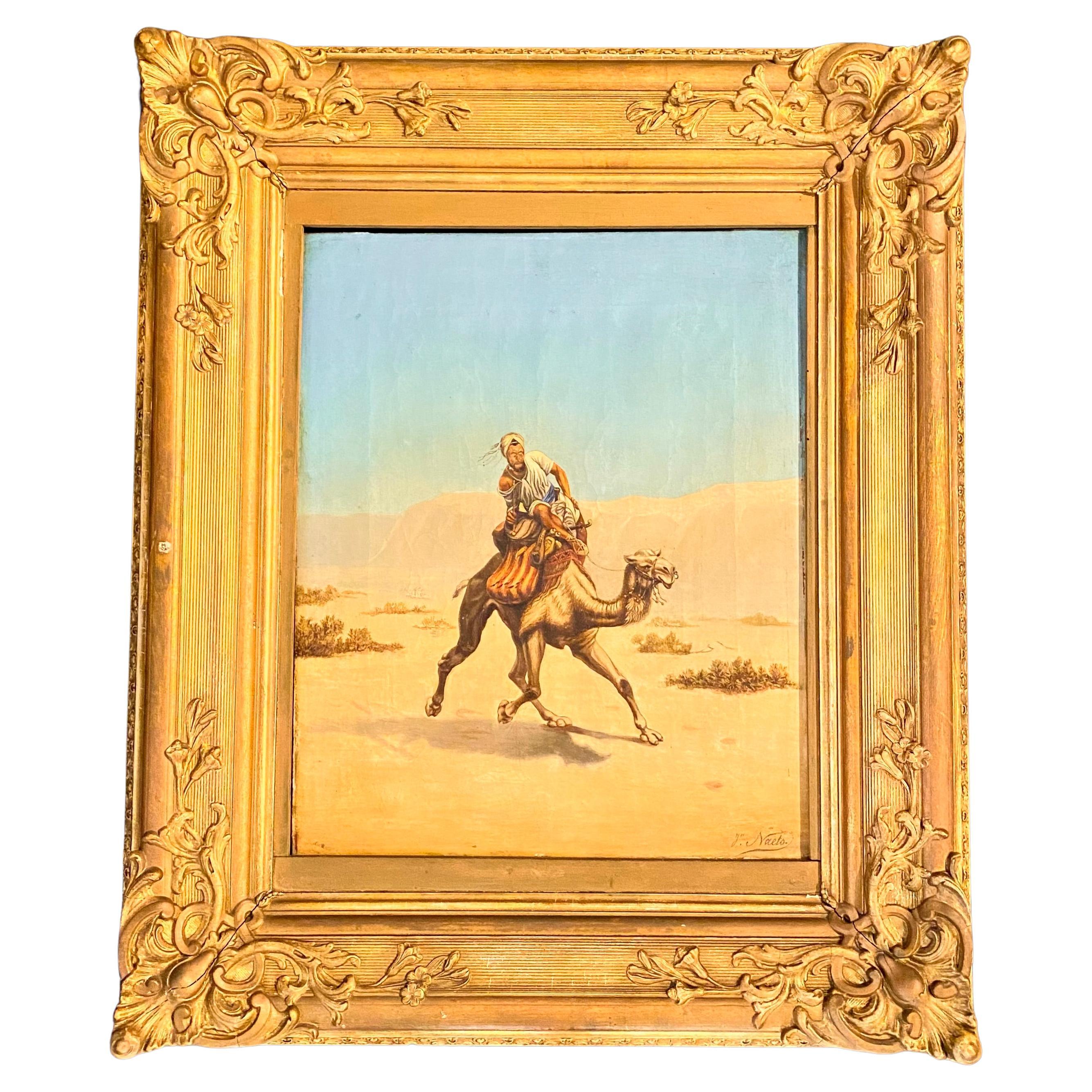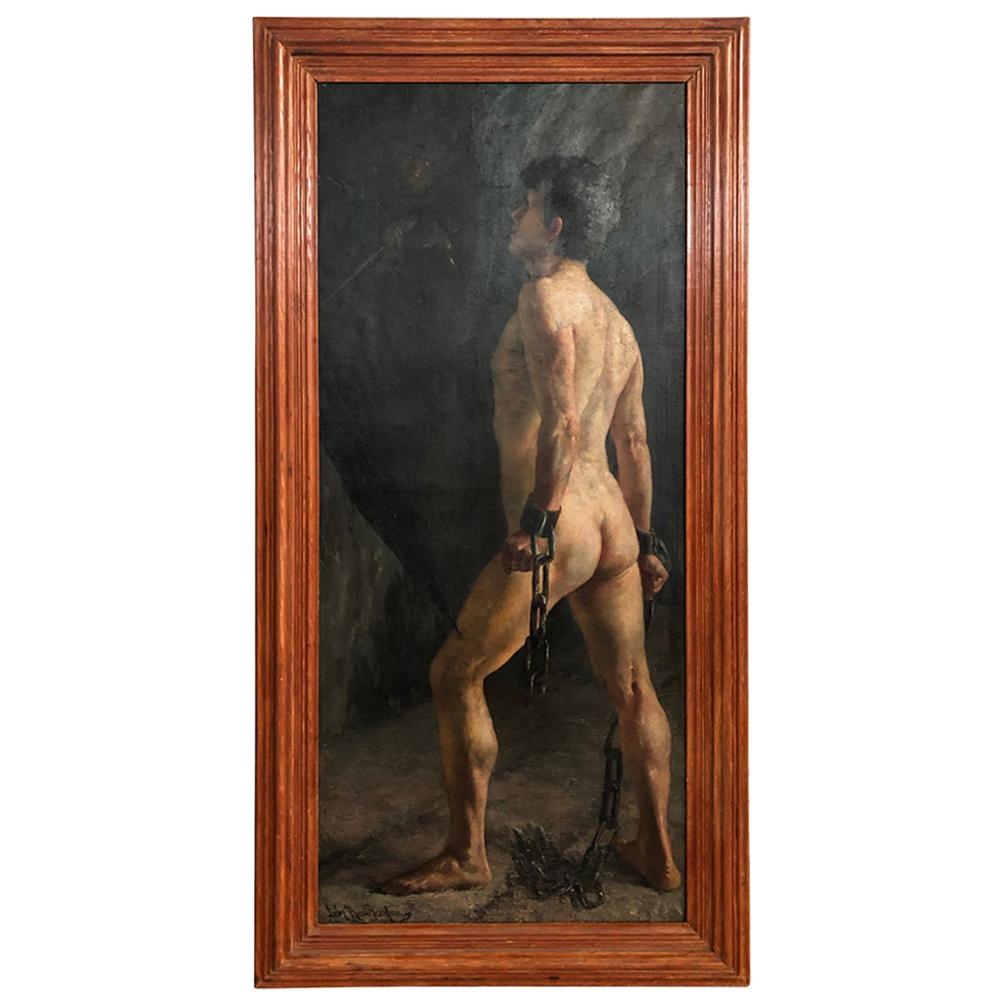Items Similar to Franz Gailliard Large Oil on Canvas La Place Sainte Gudule
Want more images or videos?
Request additional images or videos from the seller
1 of 13
Franz Gailliard Large Oil on Canvas La Place Sainte Gudule
About the Item
Franz (Bernard) Gailliard (Belgian, 1861-1932) "La Place Sainte Gudule a` Bruxelles Apre`s Le Carnaval" A fine and large oil on canvas depicting a street scene in late 19th century Brussels - La Place Sainte Gudule - after the Carnaval. Unframed. Signed: F. GAILLIARD (l/r), circa 1890.
Measures: Canvas height: 95 inches (241.3 cm).
Canvas width: 84 1/2 inches (214.6 cm).
Franz F.D.A. Gailliard (1861-1932) was a Belgian Neo-Impressionnist and Luminist painter of figures, portraits, landscapes and beach scenes. He was also a reporter, watercolourist and draughtsman for French, English and Belgian lifestyle magazines and newspapers such as the French Le Patriote illustre´, Belgian Le Petit Bleu and English London Illustrated News. He received his artistic education at the Academy of Brussels under the tutorship of Jean Portaels, Joseph Stallaert and Franc¸ois Bossuet. Gailliard also studied at the Brussels Academy of Beaux-Arts and in Paris under the supervision of Jean-Le´on Ge´ro^me (French, 1824–1904) and followed class together with his contemporaries James Ensor, Le´on Fre´de´ric and Fernand Khnopff. He met up with the renowned American painter James Whistler in 1887 and showed him around Brussels. He was the first artist to introduce the "dripping" method in 1891. After having painting in a realist and traditional style, he got influenced by the Impressionist French School, and headed toward a "luministe-divisionniste" technique in his latest period. He exhibited at the Brussels Salon, and at the Salon des Artistes Franc¸ais in Paris from 1882 to 1891, as well as in Venice and Du¨sseldorf. Gailliard exhibited his oeuvre at the "Cercle Artistique et Litte´raire" in Brussels in 1910 and 1913. He became eventually director at the Academy of Sint-Gillis where his son Jean-Jacques Gailliard took class in order to also become painter. A retrospective was held in is honour is 1957 in Sint-Gillis. Even though he was influenced by the Art Deco aesthetics after the First War, he never stopped studying and experimenting with light.
Gailliard exhibied at The Esposizione Internazionale d'Arte della Citta` di Venezia (Venice) in 1909 and at La Biennale di Venezia, (Venice) in 1907. He also exhibited at Le Muse´e d'Ixelles, Brussels. Gailliard died in Brussels on February 16, 1932.
Museums:
Muse´e d'Ixelles, Brussels
Acknowledgments:
Biography information of Gailliard was obtained from Galerie Ary Jan in Paris.
This painting was previously offered at Bonhams New York on May 06, 2009, Sale Number 17454, "The Severin Wunderman Collection", Lot 4247W.
The current auction record for the artist Franz (Bernard) Gailliard (Belgian, 1861-1932) was an oil on canvas titled "Au Soleil" (51" x 67") sold at Sotheby's London on November 30, 1988, Lot 178 for £60,000 GBP ($110,970 USD).
- Creator:Franz (Bernard) Gailliard 1 (Artist)
- Dimensions:Height: 84.75 in (215.27 cm)Width: 95 in (241.3 cm)Depth: 1.5 in (3.81 cm)
- Style:Other (In the Style Of)
- Materials and Techniques:
- Place of Origin:
- Period:
- Date of Manufacture:circa 1890
- Condition:Wear consistent with age and use. Minor fading. A truly great quality, very impressive and beautifully executed large artwork. Overall condition is very good with some touch-ups. Please view all images. Unframed.
- Seller Location:Los Angeles, CA
- Reference Number:
About the Seller
5.0
Vetted Seller
These experienced sellers undergo a comprehensive evaluation by our team of in-house experts.
Established in 1982
1stDibs seller since 2016
114 sales on 1stDibs
Typical response time: <1 hour
- ShippingRetrieving quote...Ships From: Los Angeles, CA
- Return PolicyThis item cannot be returned.
More From This SellerView All
- Very Fine and Large Orientalist Oil on Canvas Titled "Ashura Rituals, Tangier"By Gordon B. Coutts 1Located in Los Angeles, CAGordon B. Coutts (Scottish/American, 1868-1937) A very fine and large orientalist oil on canvas titled "Ashura Rituals, Tangier" (Arabic: عاشوراء ʻĀshūrā’ - Urdu: عاشورا - Persian: عاشورا - Turkish: Aşure Günü). Signed and inscribed: 'Gordon Coutts/TANGIER' (lower right), circa 1920. Provenance: The Fisher Art Museum, University of Southern California. Gordon Coutts led a peripatetic career, born in Aberdeen, Scotland, he then studied and travelled to Glasgow, London, Paris and Rome before settling in Melbourne, Australia in 1891. In 1896 he moved to Sydney, where he taught at the Art Society of New South Wales, before returning back to Europe in 1899. With the climate of northern Europe detrimental to Coutts' poor health, he moved with his wife, Alice Grey, to the United States where he became a frequent exhibitor at the Bohemian Club in San Francisco. In 1920 he travelled to Tangiers, Morocco where, dressed as an Arab, he passed from tribe to tribe observing the lifestyle, customs and practices of the the village people and Bedouins. The present work depicts the celebration of Ashura. The day of Ashura is commemorated by Shi'ite Muslims; "A day of pain, pilgrimage and pageantry, it is one of the holiest in their religion. The word Ashura means 10, and refers to the tenth day of Muharram, the first month of the Islamic calendar. This is a period of mourning and cleansing, which marks the martyrdom of Hussein, grandson of the Prophet Muhammad...Category
Early 20th Century Moroccan Other Paintings
MaterialsCanvas
- Felix Possart Large Oil on Canvas "A Spring Alpine Journey"By Felix PossartLocated in Los Angeles, CAFelix Possart (German, 1837-1928) a large oil on canvas "A Spring Alpine Journey". The elongated painting depicting a mountain scene, possibly set in the Austrian or Swiss Alps, of a...Category
Antique Late 19th Century German Black Forest Paintings
MaterialsGiltwood, Canvas
- Pietro Gabrini Large Oil on Canvas "Three Singing Beauties"By Pietro Gabrini 1Located in Los Angeles, CAPietro Gabrini (Italian, 1856-1926) a very fine and large oil on canvas "Three Singing Beauties" depicting three cheerful Village young maidens walking through a road path while embr...Category
Antique Late 19th Century Italian Baroque Revival Paintings
MaterialsCanvas, Wood
- Wenzel Ulrik Tornøe a Large Oil on Canvas "the Sewing Room"Located in Los Angeles, CAWenzel Ulrik Tornøe (Danish, 1844-1907) A very fine and large oil on canvas titled "Systue" ("The Sewing Room"). The finely executed artwork depicting the interior of a sewing room w...Category
Antique 19th Century Danish Beaux Arts Paintings
MaterialsCanvas, Giltwood
- After Raffaello Sanzio 1483-1520 Raphael La Madonna della Seggiola Oil on CanvasBy (after) Raphael (Raffaello Sanzio da Urbino)Located in Los Angeles, CAA Fine Italian 19th Century Oil Painting on Canvas "La Madonna della Seggiola" after Raphael (Raffaello Sanzio da Urbino 1483-1520). The circular painted canvas depicting a seated Madonna holding an infant Jesus Christ next to a child Saint John the Baptist, all within a massive carved gilt wood and gesso frame, which is identical to the frame on Raphael's original artwork. This painting is a 19th Century copy of Raphael's Madonna della Seggiola painted in 1514 and currently exhibited and part of the permanent collection at the Palazzo Pitti, Galleria Palatina, Florence, Italy. The bodies of the Virgin, Christ, and the boy Baptist fill the whole picture. The tender, natural looking embrace of the Mother and Child, and the harmonious grouping of the figures in the round, have made this one of Raphael's most popular Madonnas. The isolated chair leg is reminiscent of papal furniture, which has led to the assumption that Leo X himself commissioned the painting. A retailer's label reads " Fred K/ Keer's Sons - Framers and Fine Art Dealers - 917 Broad St. Newark, N.J." - Another label from the gilder reads "Carlo Bartolini - Doratore e Verniciatori - Via Maggio 1924 - Firenze". Circa: 1890-1900. Subject: Religious painting Canvas diameter: 28 inches (71.1 cm) Frame height: 54 inches (137.2 cm) Frame width: 42 1/2 inches (108 cm) Frame depth: 5 1/2 inches (14 cm) Raffaello Sanzio da Urbino (Italian, March 28 or April 6, 1483 - April 6, 1520), known as Raphael, was an Italian painter and architect of the High Renaissance. His work is admired for its clarity of form, ease of composition, and visual achievement of the Neoplatonic ideal of human grandeur. Together with Michelangelo and Leonardo da Vinci, he forms the traditional trinity of great masters of that period. Raphael was enormously productive, running an unusually large workshop and, despite his death at 37, leaving a large body of work. Many of his works are found in the Vatican Palace, where the frescoed Raphael Rooms were the central, and the largest, work of his career. The best known work is The School of Athens in the Vatican Stanza della Segnatura. After his early years in Rome much of his work was executed by his workshop from his drawings, with considerable loss of quality. He was extremely influential in his lifetime, though outside Rome his work was mostly known from his collaborative printmaking. After his death, the influence of his great rival Michelangelo was more widespread until the 18th and 19th centuries, when Raphael's more serene and harmonious qualities were again regarded as the highest models. His career falls naturally into three phases and three styles, first described by Giorgio Vasari: his early years in Umbria, then a period of about four years (1504–1508) absorbing the artistic traditions of Florence, followed by his last hectic and triumphant twelve years in Rome, working for two Popes and their close associates. Raphael was born in the small but artistically significant central Italian city of Urbino in the Marche region, where his father Giovanni Santi was court painter to the Duke. The reputation of the court had been established by Federico III da Montefeltro, a highly successful condottiere who had been created Duke of Urbino by the Pope - Urbino formed part of the Papal States - and who died the year before Raphael was born. The emphasis of Federico's court was rather more literary than artistic, but Giovanni Santi was a poet of sorts as well as a painter, and had written a rhymed chronicle of the life of Federico, and both wrote the texts and produced the decor for masque-like court entertainments. His poem to Federico shows him as keen to show awareness of the most advanced North Italian painters, and Early Netherlandish artists as well. In the very small court of Urbino he was probably more integrated into the central circle of the ruling family than most court painters. Federico was succeeded by his son Guidobaldo da Montefeltro, who married Elisabetta Gonzaga, daughter of the ruler of Mantua, the most brilliant of the smaller Italian courts for both music and the visual arts. Under them, the court continued as a centre for literary culture. Growing up in the circle of this small court gave Raphael the excellent manners and social skills stressed by Vasari. Court life in Urbino at just after this period was to become set as the model of the virtues of the Italian humanist court through Baldassare Castiglione's depiction of it in his classic work The Book of the Courtier, published in 1528. Castiglione moved to Urbino in 1504, when Raphael was no longer based there but frequently visited, and they became good friends. He became close to other regular visitors to the court: Pietro Bibbiena and Pietro Bembo, both later cardinals, were already becoming well known as writers, and would be in Rome during Raphael's period there. Raphael mixed easily in the highest circles throughout his life, one of the factors that tended to give a misleading impression of effortlessness to his career. He did not receive a full humanistic education however; it is unclear how easily he read Latin. Early Life and Works His mother Màgia died in 1491 when Raphael was eight, followed on August 1, 1494 by his father, who had already remarried. Raphael was thus orphaned at eleven; his formal guardian became his only paternal uncle Bartolomeo, a priest, who subsequently engaged in litigation with his stepmother. He probably continued to live with his stepmother when not staying as an apprentice with a master. He had already shown talent, according to Vasari, who says that Raphael had been "a great help to his father". A self-portrait drawing from his teenage years shows his precocity. His father's workshop continued and, probably together with his stepmother, Raphael evidently played a part in managing it from a very early age. In Urbino, he came into contact with the works of Paolo Uccello, previously the court painter (d. 1475), and Luca Signorelli, who until 1498 was based in nearby Città di Castello. According to Vasari, his father placed him in the workshop of the Umbrian master Pietro Perugino as an apprentice "despite the tears of his mother". The evidence of an apprenticeship comes only from Vasari and another source, and has been disputed—eight was very early for an apprenticeship to begin. An alternative theory is that he received at least some training from Timoteo Viti, who acted as court painter in Urbino from 1495.Most modern historians agree that Raphael at least worked as an assistant to Perugino from around 1500; the influence of Perugino on Raphael's early work is very clear: "probably no other pupil of genius has ever absorbed so much of his master's teaching as Raphael did", according to Wölfflin. Vasari wrote that it was impossible to distinguish between their hands at this period, but many modern art historians claim to do better and detect his hand in specific areas of works by Perugino or his workshop. Apart from stylistic closeness, their techniques are very similar as well, for example having paint applied thickly, using an oil varnish medium, in shadows and darker garments, but very thinly on flesh areas. An excess of resin in the varnish often causes cracking of areas of paint in the works of both masters. The Perugino workshop was active in both Perugia and Florence, perhaps maintaining two permanent branches. Raphael is described as a "master", that is to say fully trained, in December 1500. His first documented work was the Baronci altarpiece for the church of Saint Nicholas of Tolentino in Città di Castello, a town halfway between Perugia and Urbino. Evangelista da Pian di Meleto, who had worked for his father, was also named in the commission. It was commissioned in 1500 and finished in 1501; now only some cut sections and a preparatory drawing remain. In the following years he painted works for other churches there, including the Mond Crucifixion (about 1503) and the Brera Wedding of the Virgin (1504), and for Perugia, such as the Oddi Altarpiece. He very probably also visited Florence in this period. These are large works, some in fresco, where Raphael confidently marshals his compositions in the somewhat static style of Perugino. He also painted many small and exquisite cabinet paintings in these years, probably mostly for the connoisseurs in the Urbino court, like the Three Graces and St. Michael, and he began to paint Madonnas and portraits. In 1502 he went to Siena at the invitation of another pupil of Perugino, Pinturicchio, "being a friend of Raphael and knowing him to be a draughtsman of the highest quality" to help with the cartoons, and very likely the designs, for a fresco series in the Piccolomini Library in Siena Cathedral. He was evidently already much in demand even at this early stage in his career. Influence of Florence Raphael led a "nomadic" life, working in various centres in Northern Italy, but spent a good deal of time in Florence, perhaps from about 1504. Although there is traditional reference to a "Florentine period...Category
Antique Early 1900s Italian Baroque Paintings
MaterialsCanvas, Giltwood
- After Raffaello Sanzio 1483-1520 Raphael La Madonna Della Seggiola Oil on CanvasBy (after) Raphael (Raffaello Sanzio da Urbino)Located in Los Angeles, CAA fine Italian 19th century oil painting on canvas "La Madonna della Seggiola" after Raphael (Raffaello Sanzio da Urbino 1483-1520). The circular painted canvas depicting a seated Ma...Category
Antique Late 19th Century Italian Baroque Paintings
MaterialsCanvas, Giltwood
You May Also Like
- Large Impressionist Oil Painting on Canvas Signed R. BlumLocated in Houston, TXLarge Impressionist oil painting on canvas Signed R. Blum. Beautifully executed antique impressionist oil painting on canvas signed R. Blum. This lovely large oil painting possibly d...Category
Vintage 1920s European Other Paintings
MaterialsCanvas
- Large "Zebra" Oil Painting on CanvasLocated in Brooklyn, NYThis large piece of wall art features bold colors and eye-catching lines. Painted on canvas this piece is sure to turn heads. Please confirm the item location with the dealer. (NJ/NY).Category
Mid-20th Century Mid-Century Modern Decorative Art
MaterialsCanvas, Acrylic
- John Lochhead "the Trysting Place" Oil on Canvas in Period FrameLocated in San Francisco, CAA pretty oil on canvas by John Lochhead (1868-1921) a listed British artist born in 1868. The style of the painting is classic Victorian with a slightly naughty title on the back label "The Trysting Place". The piece depicts a well-dressed young woman seated on a bench in a charming bucolic garden setting with grazing sheep on a riverbank. The frame is a fine example of elaborate late 19th century carved giltwood with the label of a well-known carver and gilder...Category
Early 20th Century English Victorian Paintings
MaterialsGiltwood, Paint
- 18th Century Austrian Baroque Oil on Canvas Painting by Franz Xaver HornöckBy Franz Xaver HornöckLocated in West Palm Beach, FLA light-brown, green antique Austrian Baroque oil on canvas painting by Franz Xaver Hornöck in a hand crafted original black, partly gilded wooden frame, in good condition. The vinta...Category
Antique 18th Century Austrian Baroque Decorative Art
MaterialsCanvas, Wood
- French Large Orientalist Painting, Signed "JH Naets", Oil on CanvasLocated in Montreal, QuebecFrench Large Orientalist Painting, Signed "JH Naets", on the lower, right-hand corner. Oil on Canvas, 19th-Century, beautifully framed. ...Category
Antique 19th Century French Other Paintings
MaterialsWood, Giltwood, Canvas
- Large Scale Italian Oil on Canvas PaintingLocated in Atlanta, GAAn outstanding and grand scale oil on canvas painting of a nude male. Entitled "La Vittoria Della Verita' Sull'Insidia" - "The Victory Of Truth Over The Trap"..... Expertly executed ...Category
Early 20th Century Italian Paintings
MaterialsCanvas
